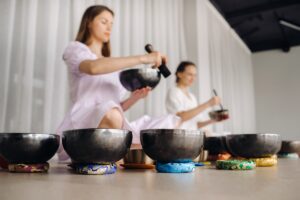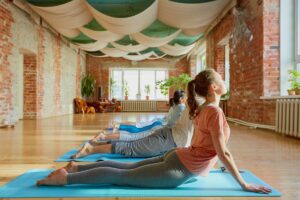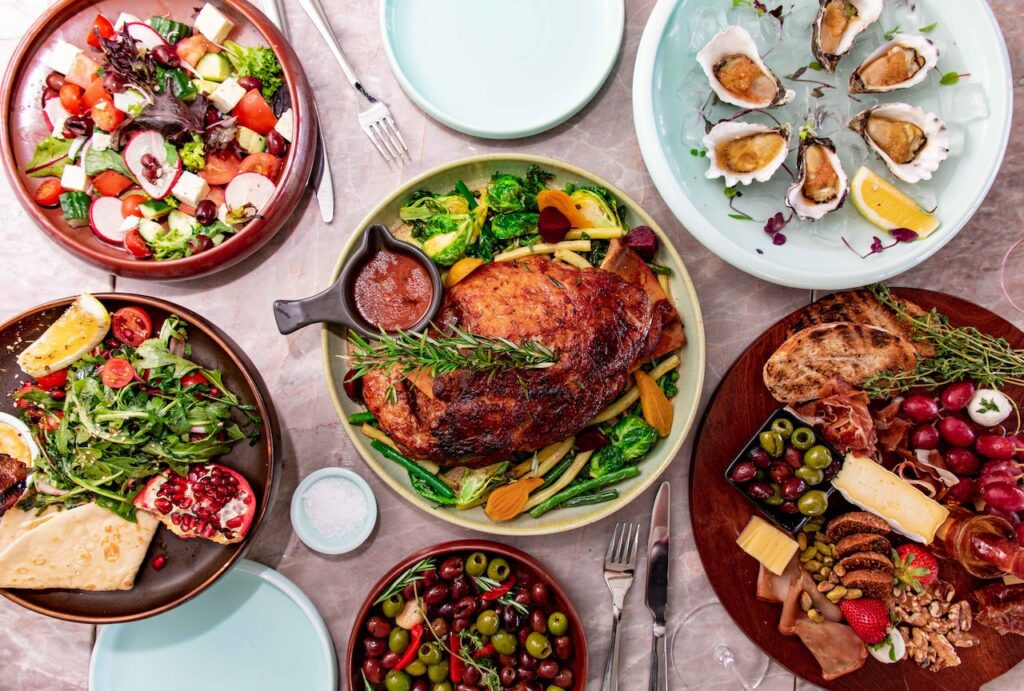Want to improve your yoga? Want to make your experience better? This article will cover eight essential yoga accessories for all ages and experience levels. These items will enrich your practice, improve your posture, and enhance your experience, whether you’re a beginner or a seasoned yogi. From blocks to straps and mats, get ready to discover the top products that will change your yoga experience!
Why is yoga equipment needed? First, they make postures easier and safer. They may also support, soothe, and stabilize our practice. Moreover, you’ll look good and feel confident!
This blog article will examine each accessory’s advantages and correct usage. We’ll also provide practice optimization recommendations and other surprising perks for each item.
Grab your mat, throw on your favorite yoga pants, and get ready to level up with these essential yoga gear. You’ll feel better!
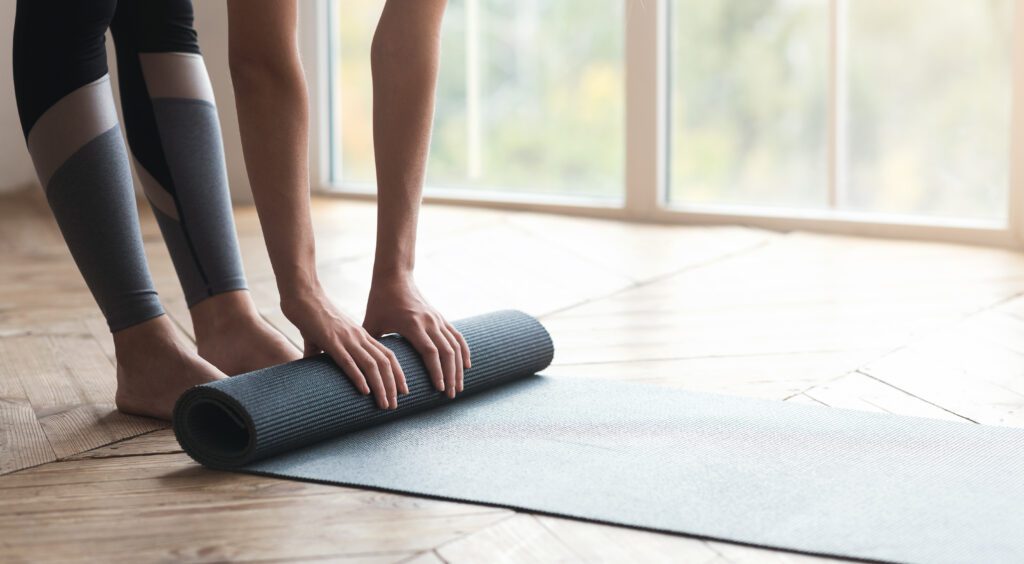
Yoga Mats
Yoga mats are thin, lightweight, and non-slip. They’re usually made of rubber, PVC, or a mix of the two and come in varying thicknesses and textures to suit different applications. Yoga mats allow practitioners to stand, sit, or sleep comfortably and safely throughout practice. Their surface protects the wrists, knees, and spine from the hard floor, preventing slippage in poses like Downward Dog and Warrior. An excellent yoga mat is sturdy, simple to clean, and provides appropriate traction and cushioning for the practitioner.
Yoga mats come in several styles to meet different demands. Consider these:
- Eco-friendly mats: Made from natural rubber, jute, or recycled PVC, these mats lessen the environmental effects.
- Thick mats: Try a thick mat if your joints require more cushioning.
- Non-slip mats: These mats have a rough surface to avoid slippage, making them excellent for sweaty or humid practitioners.
- Travel mats: Lightweight and compact, these mats are simple to carry. These may not be as thick or robust as other mats, but they help while traveling.
- Extra-long mats: If you’re tall or want more room, an extra-long mat may work for you. These mats are at least 72 inches long and allow for all positions.
Click HERE to check the price on AMAZON!
Yoga Blocks
Yoga blocks are robust, lightweight foam blocks for balance, alignment, and changing postures. They support and stabilize hands, feet, and other body parts, letting practitioners to safely and comfortably attain and maintain postures that may otherwise be difficult or unavailable. If you can’t reach the ground in a standing forward fold (uttanasana), lay a yoga block in front of you and rest your hands on it to work up to the best position.
Blocks aid alignment. Layer a block between your legs to align your hips in positions such as Warrior II (virabhadrasana II).
Yoga blocks may support and alter positions to make them easier or harder. If tree poses (vrksasana) are difficult for you, lean a block against a wall and lay your hand on it. You may concentrate on balance and alignment without worrying about falling. To challenge and stretch the triangle position, lay a block on the ground and rest your foot on it (trikonasana).
Most yoga blocks are made of foam. Beginners may use them since they are lightweight and easy to use. Foam blocks are soft and may support certain stances. Yet, they may compress or lose form with time.
Cork yoga blocks cost more but last longer. Cork, a natural, sustainable material that resists germs and moisture, makes a sanitary yoga prop. Cork blocks are denser and stronger than foam blocks, which may appeal to experienced practitioners who seek greater support. Yet, their weight may make them uncomfortable to use and harder to move.
Recycled foam, cork, and wood are other yoga block materials. These rare and pricey materials have distinct qualities and advantages. Wood blocks are robust and natural-looking, while recycled foam blocks are eco-friendly. Choose a yoga block material based on your tastes and requirements.
Click HERE to check the price on AMAZON!
Yoga Straps
A yoga belt or strap is a long, thin piece of cloth used to stretch and reach in specific yoga positions. It is usually composed of cotton, nylon, or a similar material and includes a buckle or loop at one end to modify its length.
A yoga strap supports and extends the practitioner in positions where they cannot reach or hold their feet or hands. The practitioner may push or pull against it to deepen stretches and develop flexibility.
A strap may assist a sitting forward bender to reach their toes or a standing splitter reach the floor. These positions allow the practitioner to safely and pleasantly stretch their muscles.
Yoga straps come in various varieties, each with its own merits. Consider these:
Length: Yoga straps come in various lengths for different uses. There are shorter and longer lengths than the standard 6–8.5 feet. Choose a length that suits your height and the positions you’ll practice.
Material: Yoga straps are usually cotton, nylon, or synthetic material. Cotton straps are more pleasant but less durable than nylon straps. Nylon straps are stronger and simpler to clean than cotton straps, although they may be less comfortable. Hemp straps are also popular. Natural fiber straps are sturdy and durable, although they may not be as supple as cotton or nylon straps.
Buckle: Yoga straps may be lengthened with various buckles or loops. D-ring buckles provide fine adjustability and are the most prevalent. Loop buckles are simple and secure, although they may not be as adaptable as cinch buckles.
In restorative yoga, a long, firm cushion supports and soothes your body. A detachable, washable cotton or canvas cover covers a thick foam or other stiff substance.
In savasana (corpse position) and supported fish pose, a yoga bolster supports the body.
A bolster allows the practitioner to completely relax and sink into the position, reducing stress and tension, improving circulation, and promoting relaxation. In sitting or sleeping positions, bolsters support the back, neck, or knees, relieving pressure or pain.
Yoga bolsters come in numerous varieties, each with its own merits. Consider these factors before making a purchase:
- Shape: Different demands and preferences need varied yoga bolster shapes. Rectangular and cylindrical forms dominate (round). Rectangular bolsters support the spine in sitting or sleeping positions and are broader and shorter. Round bolsters are thinner and longer and may support the legs, back, or neck in sitting or laying positions.
- Size: Different body types need various yoga bolster sizes. Typical sizes are 6 inches x 24 inches and 8 inches x 30 inches; however, bigger and smaller sizes are available too. Choose a size that fits your height and the positions you’ll practice.
- Firmness: Yoga bolsters range from mild to firm. Choose a hardness that supports and comforts you.
Foam, rice, or buckwheat hulls are used to make yoga bolsters. Foam bolsters are comfier but less durable. Buckwheat hull bolsters are stiffer but less comfy. Rice bolsters are firm yet uncomfortable.
Click HERE to check the price on AMAZON!
Yoga Blankets
Yoga blankets are big, lightweight blankets used for warmth, support, and yoga positions. It comes in many colors and patterns and is usually made of cotton or wool.
Yoga blankets are used during restorative or relaxation postures like savasana (corpse pose) and sitting forward bend to keep you warm. A pigeon stance or supported fish pose may support and cushion the body.
In standing postures like triangle pose and warrior II, a yoga blanket may assist in maintaining perfect alignment. In these positions, a blanket supports and stretches the practitioner securely.
Yoga blankets come in numerous varieties, each with its own merits. Consider these:
Cotton, wool, or synthetic blends are the main materials used for yoga blankets. Cotton blankets are soft, while wool blankets are warmer. Wool blankets are warmer and more durable than cotton blankets but less soft. Synthetic mix blankets combine natural and synthetic fibers for warmth, softness, and durability.
There are just two factors to choosing the right blanket for you:
- Weight: Yoga blankets are lightweight to hefty. Lightweight blankets are easy to carry and drape but may not be as warm. Thick blankets are warmer and stronger but heavier to transport and use.
- Size: Yoga blankets come in various sizes for different uses. Typical sizes are 50 x 60 inches to 60 x 80 inches, although bigger and smaller sizes are available. Choose a size that fits your space and positions.
Click HERE to check the price on AMAZON!
Yoga Towels
A yoga towel is a small, absorbent towel used to cover a yoga mat, absorb perspiration during hot yoga, or support particular yoga positions. Microfiber or another synthetic material makes it lightweight, quick-drying, and ultra-absorbent.
Yoga towels cover yoga mats to prevent sweat, germs, and bacteria from spreading. It absorbs sweat during hot yoga, preventing mat slippage.
In certain positions, a yoga towel may support or extend the practitioner.
A towel may assist a practitioner in elevating their heels off the mat in a downward-facing dog or deepen the stretch in a pigeon position. These positions may be supported and stretched safely using a towel.
Yoga towels come in various varieties, each with its own perks, including:
- Material: Microfiber, cotton, or synthetic blends make yoga towels. Microfiber towels are lightweight, quick-drying, and ultra-absorbent but are not as soft as cotton towels. Cotton towels are softer but less absorbent than microfiber towels. Synthetic mix towels combine natural and synthetic fibers for optimum absorbency, softness, and durability.
- Size: Yoga towels come in various sizes for different requirements. Typical sizes are 24 inches x 72 inches and 26 inches x 72 inches, although bigger and smaller sizes are available. Choose a size that fits your mat and the positions you’ll do.
- Thickness: Yoga towels range from thin and lightweight to thick and luxurious. Thin towels may absorb less but are easy to pack and transport. Thick towels are more cushioned and absorbent but harder to pack and transport.
Click HERE to check the price on AMAZON!
Eye Pillows
An eye pillow is a tiny, soft cushion stuffed with flaxseed, grains, or lavender to cover the eyes and relieve tension during various yoga practices. They come in a variety of colors and smells and is usually composed of cotton or silk.
Basically, you get to focus on the present moment better by covering your eyes with an eye cushion, which helps relieve stress and anxiety and improve inner serenity and clarity. Lavender and chamomile are commonly added to eye pillows to improve their soothing benefits.
Here are the main aspects to consider for the perfect eye pillow:
- Material: Cotton, silk, or synthetic blends make eye pillows. Cotton eye pillows are soft, while silk ones are more sumptuous and lasting. Silk eye pillows are more expensive and durable than cotton ones, although they may be less pleasant. Soft, durable, and comfortable synthetic mix eye pillows combine natural and synthetic fibers.
- Filling: Eye pillows may be filled with flaxseed, rice, lavender, or chamomile. Flaxseed eye pillows are light and fragrant, although they may not be as cushioned as rice or lavender ones. Rice eye pillows are thicker and more cushioned but less fragrant than flaxseed or lavender ones. Lavender eye pillows are pleasant and calming, although they may be heavier and less cushioned than flaxseed or rice eye pillows. Chamomile eye pillows also soothe.
Click HERE to check the price on AMAZON!
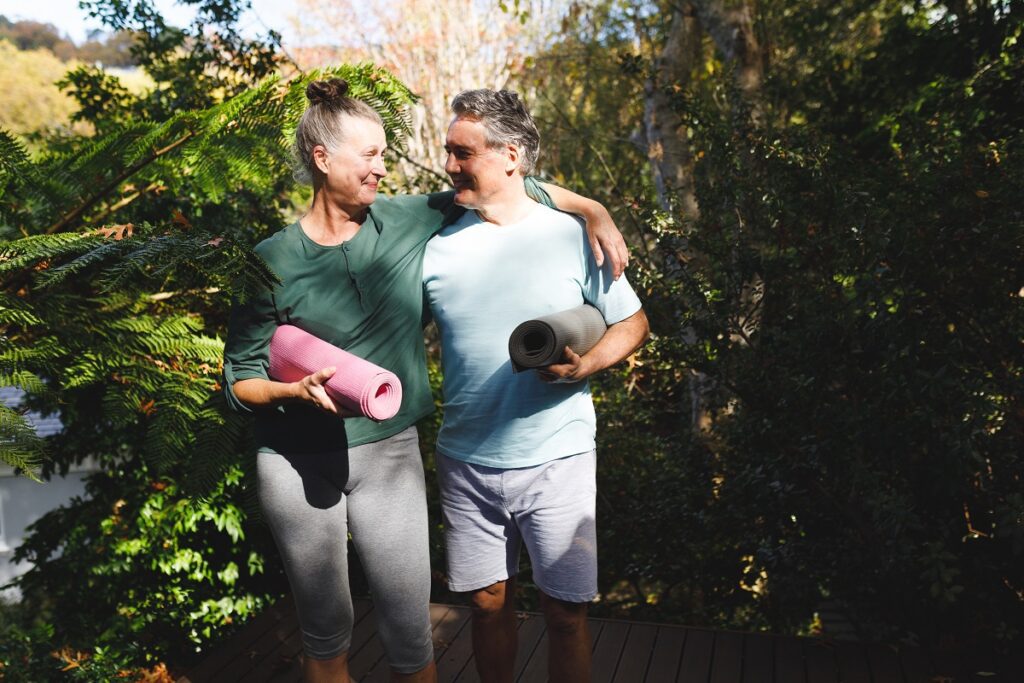
Conclusion
Yoga accouterments, including mats, blocks, straps, bolsters, blankets, towels, and eye pillows, provide support, comfort, and stability. They may also change positions to make them easier or more complex, depending on your experience.
Yoga equipment may assist novices in learning postures and utilizing supports. They may also help expert practitioners develop their practice or vary their practices.
Yoga accouterments make practice more fun and comfortable. A non-slip mat may assist you in remaining in balancing poses, and a bolster can give additional support and comfort in restorative positions. An eye cushion may help you relax in savasana or meditation, while a towel helps absorb sweat in hot yoga.
Yoga gear may help anybody improve their practice and feel their best on and off the mat.



